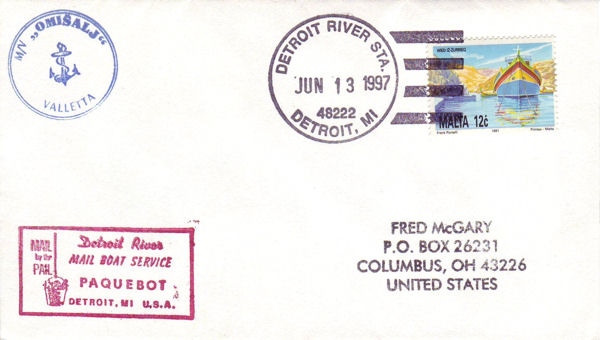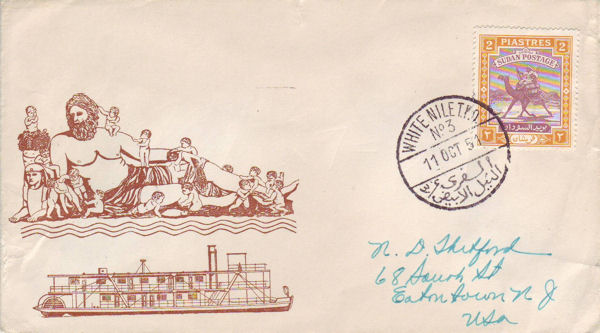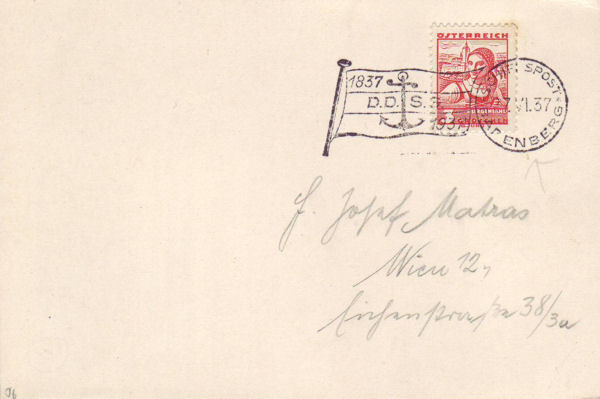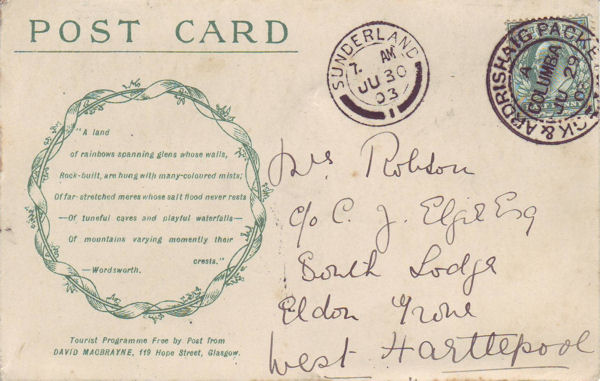Seapost -> River Post
River Post
By Geoff Ellerton
The marks available from river vessels are wide-ranging, from full "floating post offices" through transit and route markings to ship or boat cancellations, items posted into on-board mail boxes and simple souvenir or philatelically inspired cachets on (usually) postcards sold on board. All are potentially of interest and even the simplest "tourist" cachets can be exceedingly scarce, collectable and valuable.
Whilst a distinction can be drawn between seapost (generally carried over salt water) and river post ( generally fresh water), there are inevitably grey areas, as with estuary ports or rivers such as the St. Lawrence which is salty as far as Quebec, but where ships must navigate some 700 miles further inland to reach Detroit, where mail is transferred to shore by a bucket lowered to a postal service tug boat so that ships do not even need to stop moving.

Fig. 1 Cover from Maltese flag ship MS Omisala to USA cancelled "Detroit River Sta / Jun 13 1997 / 48222 Detroit MI" with "Mail by Pail Paquebot" mark (Hosking 1907)
There are a number of other inland up-river ports which handle ocean going ships and have therefore used paquebot marks, but the majority of riverine postal marks are from areas (e.g. Borneo, Africa, South America) where the river, rather than road or rail, has provided the main mode of transport and communication for isolated communities. One such is the river Nile, which formed a key link in the Overland Mail route from India to Europe in the 19th century. Travelling Post Offices are recorded on navigable stretches of the Nile from 1903, from Shellal in Egypt to Wadi Haifa in Sudan, and on the White Nile south of Khartoum.

Fig. 2 Illustrated envelope from Sudan to USA cancelled by "White Nile TPO no 3 11 Oct 51" and backstamped Khartoum
Major European rivers have for centuries been used to move freight between countries, with, for example, both the Danube and Rhine having recorded ship posts at various periods, either as postal agency or ship marks.

Fig. 3 Postcard to Vienna with special commemorative cancel for the centenary of the DDSG (Danube Steam Navigation Co) including the ship's name "1837 DDSG / 1937 Schiffspost Bapenburg 27.VI.37"
The UK's major contribution to river post is made by the Firth of Clyde and its floating post offices: the Greenock and Ardrishaig Packets. Whilst the earliest recorded Clyde steamer postal mark is the "Campbelton Steam Boat" of 1830, the G&AP postal service did not commence until 1879 with sorting and stamping on the paddle steamer "Columba" and continued until 1917. Four vessels were used: Columba, Iona, Grenadier and Chevalier, with a variety of cancellations, with and without the steamer's name.

Fig. 4 Promotional postcard of "McBrayne's Glagow and Highland Royal Mail Steamers" posted on board RMS Columba with cancellation "GK & Ardrishaig Packet / A / Columba / JU 29 03" and receiving stamp of Sunderland JU 30 03.
The Caledonian McBrayne fleet on the Clyde continued to provide a wealth of material for collectors of its ships' "Posted on Board ..." cachets, particularly from its excursion steamers in the 1950's and 1960's, but there were no longer any official postal markings, although the company continued to have a contract to transport mail to the Scottish islands.
Bibliography:
RM Hosking: Paquebot cancellations of the world 3rd ed. (Cavendish 2000)
JA Mackay: The floating post offices of the Clyde (Dumfries 1971)
E Antonini & J Grasset: Histoire postale des lacs et des rivieres du monde (Feldman 1984)

